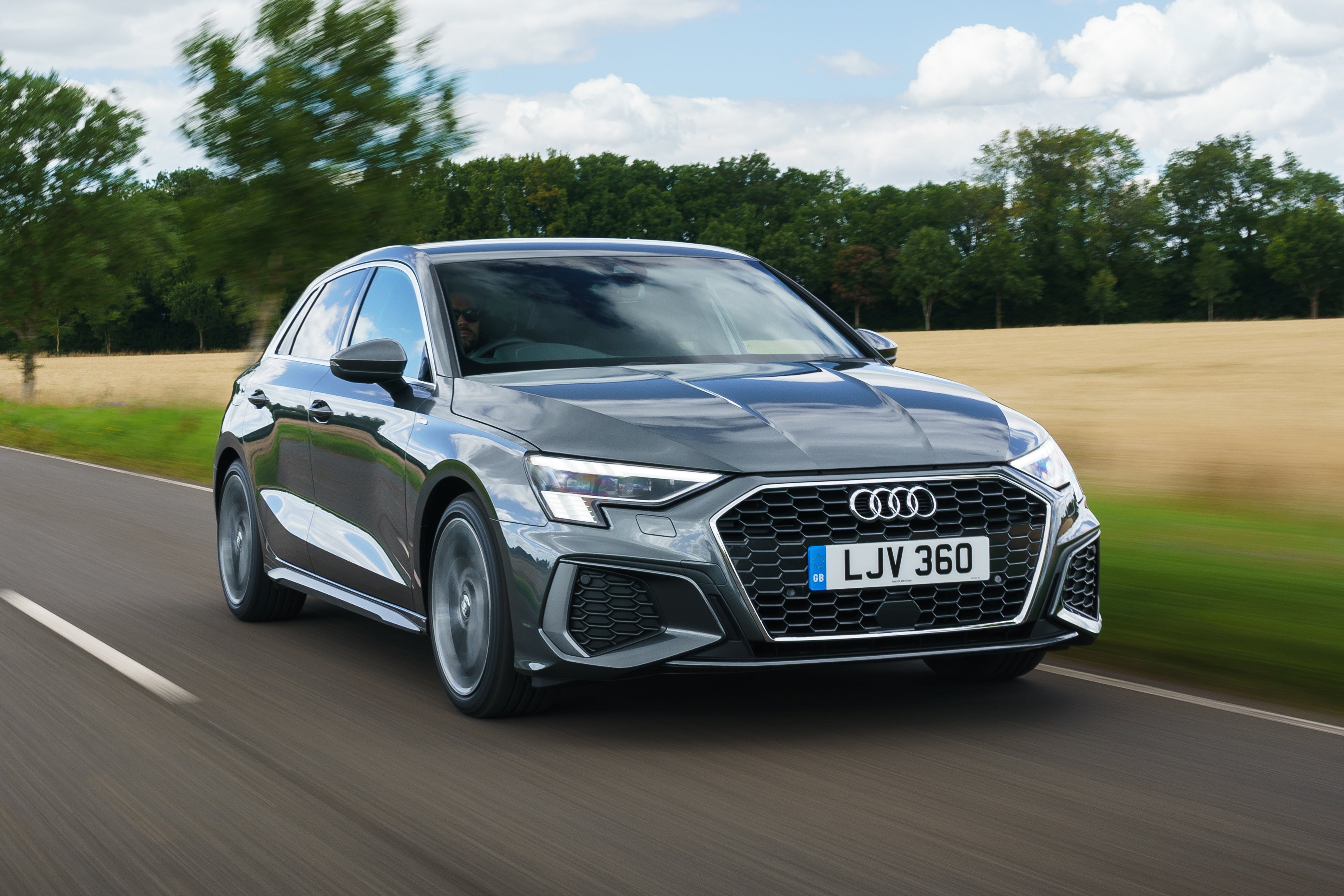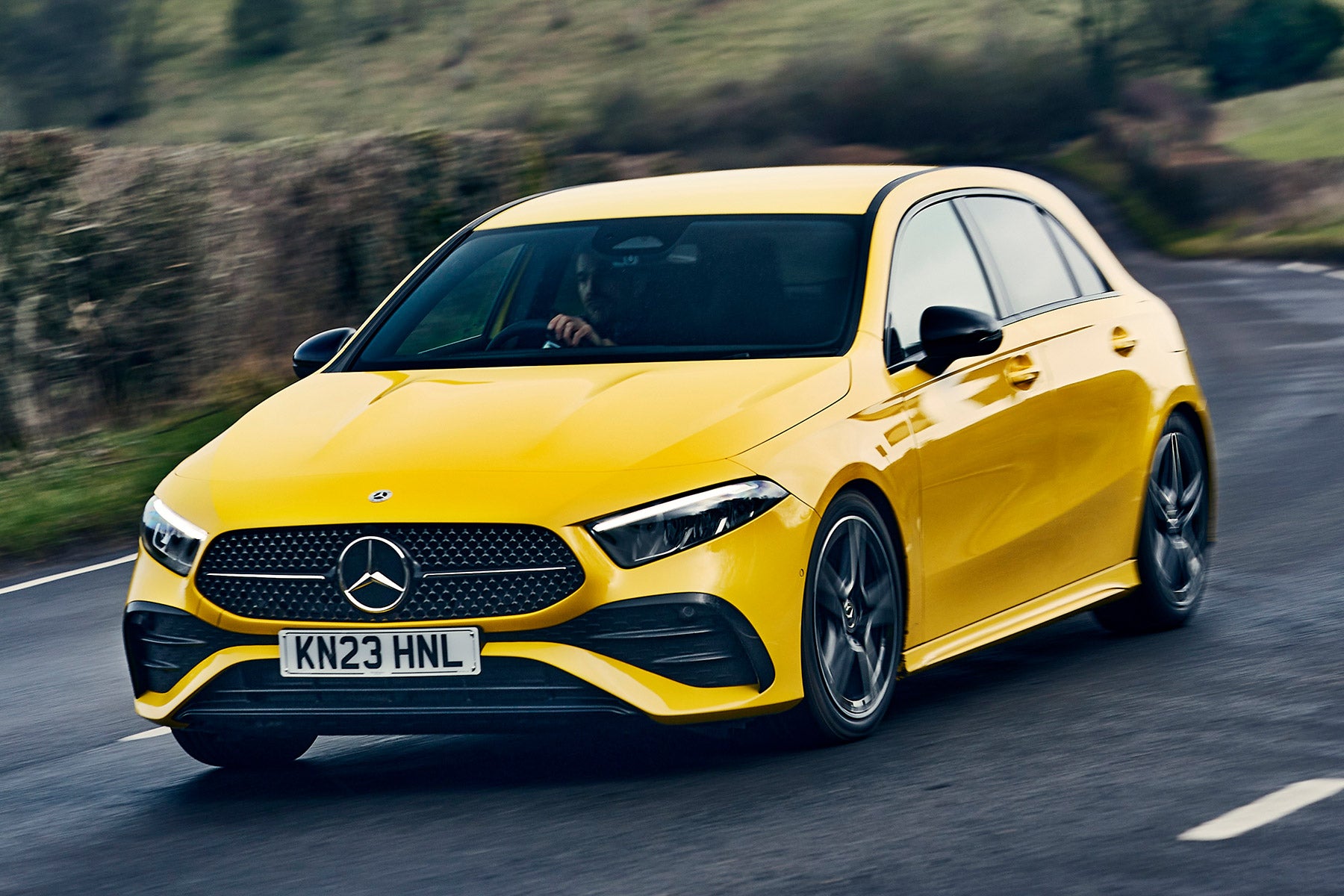Volkswagen Golf Review 2023
Written by Andrew Brady
Quick overview
Pros
- Comfortable, refined and good to drive
- Even the most affordable models are well-equipped
- Running costs won’t break the bank
Cons
- Media system is irritating to use on the move
- Parts of the cabin aren't as plush as you might expect
- Pricier than a number of rivals
Overall verdict on the Volkswagen Golf
"The Volkswagen Golf has more competition than ever, yet it remains one of the best cars in its class. It’s good to drive, has a sharp interior and we quite like how it looks, too. It’s loaded with standard equipment, including an infotainment system which looks brilliant but can be irritating to use on the move. Still, that’s one of the few things we can find wrong with it..."
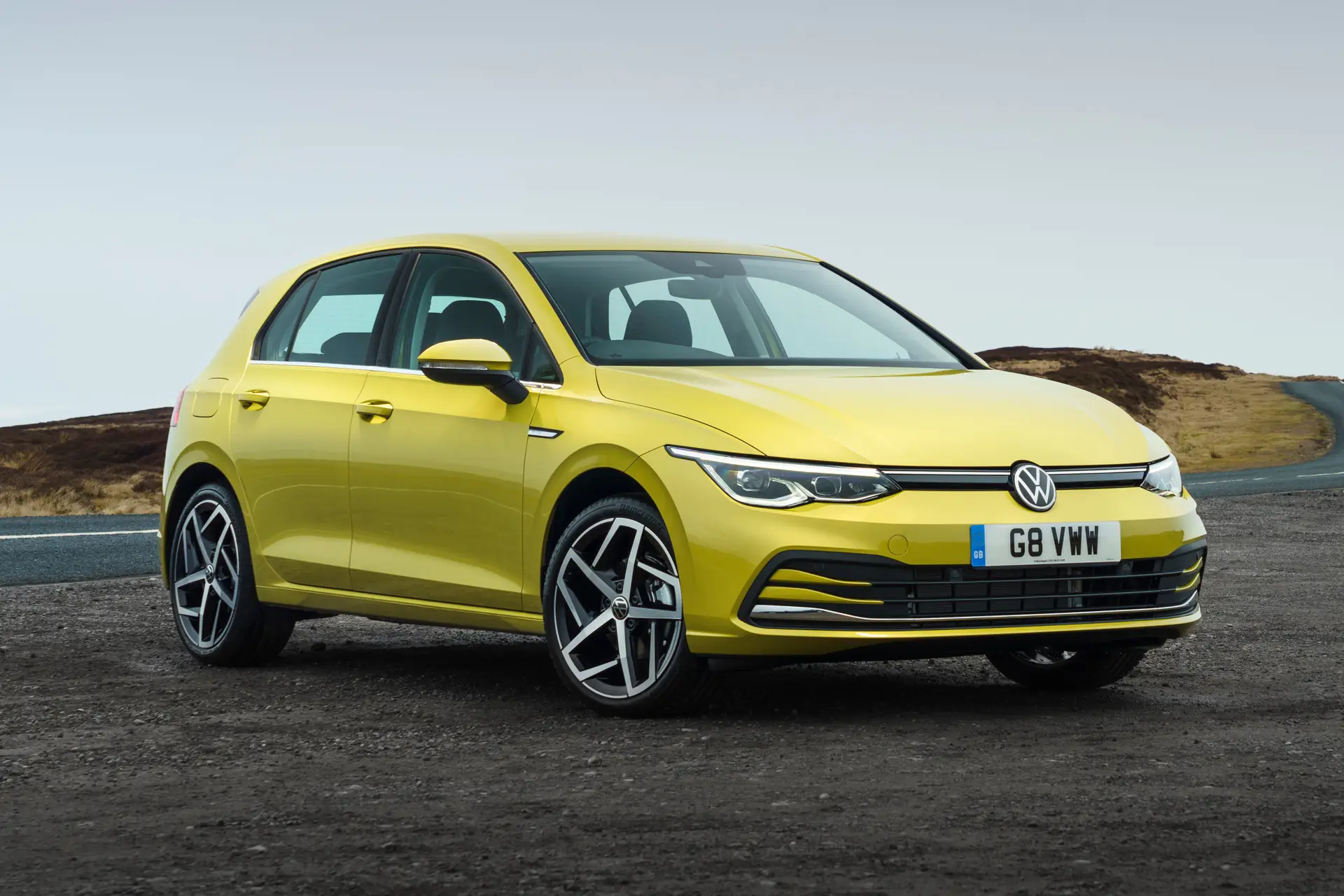
The Volkswagen Golf has been the default choice of many car buyers for decades. Whether you need a dependable family car, a comfortable commuter car or are downsizing from a bigger, more luxurious model, its wide range of abilities suit many needs. It's even a favourite of enthusiasts, particularly in GTI form. We're reviewing the standard car here, however.
Now in its eighth generation, the latest model is packed with digital tech and has a stylish cabin that could rival more expensive rivals. There’s a wide range of engines on offer and even the most affordable models are loaded with standard equipment.
So what’s the catch? Prices for a new Golf start at more than £23,000 - which is a chunk more than competitors like the Ford Focus, Honda Civic and Mazda 3. But it feels like a premium product, very nearly in the same league as the Mercedes-Benz A-Class, Audi A3 and BMW 1 Series. And, thanks to the wonders of depreciation, you can pick a nearly new one up for Vauxhall Astra money…
The standard Golf range is made up of three models: the Life, Style and R-Line. The Life really doesn’t feel like an entry-level model (but neither does it have an entry-level price tag, you could argue). Standard equipment on all models includes a 10-inch infotainment display (we’ll come onto that shortly…), an impressive digital instrument cluster and fancy ambient interior lighting.
The higher-spec models really start to knock on the doors of those premium alternatives. The Style gets various cosmetic and kit upgrades including 17-inch alloy wheels and some chrome exterior trim, while the R-Line features a host of bespoke exterior detailing, selectable drive modes and sports seats embossed with the R-Line logo.
All Golf models get a superb interior, with classy chrome finishes and a minimalist appearance. The media system really looks the part, with instant wow factor thanks to its sharp graphics and smartphone-like usability. It loses favour as soon as you try to use it on the move, however - a lack of conventional buttons means it can be distracting and awkward to operate on a bumpy road.
Buyers on a budget are catered for with a little 1.0-litre turbocharged petrol engine at the bottom of the range. It punches well above its weight in terms of performance, while - like all of the Golf’s engine line-up - it’ll pretty economical, too.
The 1.5-litre petrol will sell in bigger numbers. It’s available with a variety of power outputs and manual or automatic gearboxes - the latter with mild-hybrid technology to improve efficiency. There’s also the usual ultra-efficient 2.0-litre diesel engines which will suit high-mileage drivers well.
Just like every other Volkswagen Golf before it, the latest model feels solid and competent to drive. You can’t chuck it around like a Mazda 3 or Ford Focus, but it feels reassuringly solid - leaning less in the bends than crossover SUV alternatives like Volkswagen's own T-Roc.
You’ll pay more for a Volkswagen Golf over most family hatchbacks, but it’s worth every penny. Sure, it’s not without its faults, but nothing really beats it as an overall package.
Looking for a used car for sale? We've got 100s of Volkswagen Approved Used Cars for Sale for you to choose from, including a wide range of VW Golf models for sale. If you're looking for the older version, you need our Volkswagen Golf (2013-2020) review.
Is the Volkswagen Golf right for you?
The Volkswagen Golf is so good at what it does yet totally inoffensive with it, it’s hard to imagine a buyer it wouldn’t suit down to the ground. From aspirational go-getters to family buyers looking for a touch of class, the Golf will look subtle yet smart on anybody's driveway.
Not that it’s perfect for everyone. If you like to use a physical button to adjust the temperature or change the volume, you might wish to look elsewhere at cars such as the Mazda 3 or BMW 1 Series. Volkswagen used to be a byword for ergonomic design, but the latest Golf interior takes some getting used to.
It's also worth noting that the Volkswagen Golf isn't as large inside as its cheaper siblings, the Seat Leon and Skoda Octavia. The former has more leg space in the back, while the latter also has a bigger boot. Family buyers after more space for children and luggage might want to look at the estate version, or one of the huge number of mid-size SUVs on sale today.
What other cars are similar to the Volkswagen Golf?
The Volkswagen Golf might be one of the best family cars on the market, but there’s no shortage of very good alternatives for your consideration.
We’d recommend a look at the latest Mazda 3. It’s not the most practical choice and its engines aren’t as good as the Golf’s, but it has a superb cabin that actually looks and feels even posher, and is more rewarding to drive. There’s also the Ford Focus, which has always lived in the shadow of the Golf in terms of quality, but the latest model is very good and - like the Mazda - it’s fun to drive. You could also look at Volkswagen Group alternatives, like the similar yet cheaper SEAT Leon and the bigger (and more practical Skoda Octavia).
The Volkswagen Golf isn’t far off competing with more premium rivals, too. It’s very nearly in the same league as the pricier Audi A3, while we reckon it’s as good as the BMW 1 Series in many ways. If you’d like a more upmarket choice, the Mercedes A-Class is definitely worth a look.
Comfort and design: Volkswagen Golf interior
"The cabin is what really elevates the Volkswagen Golf over mainstream rivals like the Ford Focus. Even the most affordable Life trim has an interior that feels like a totally classy affair, with chrome dash inserts and quality materials."
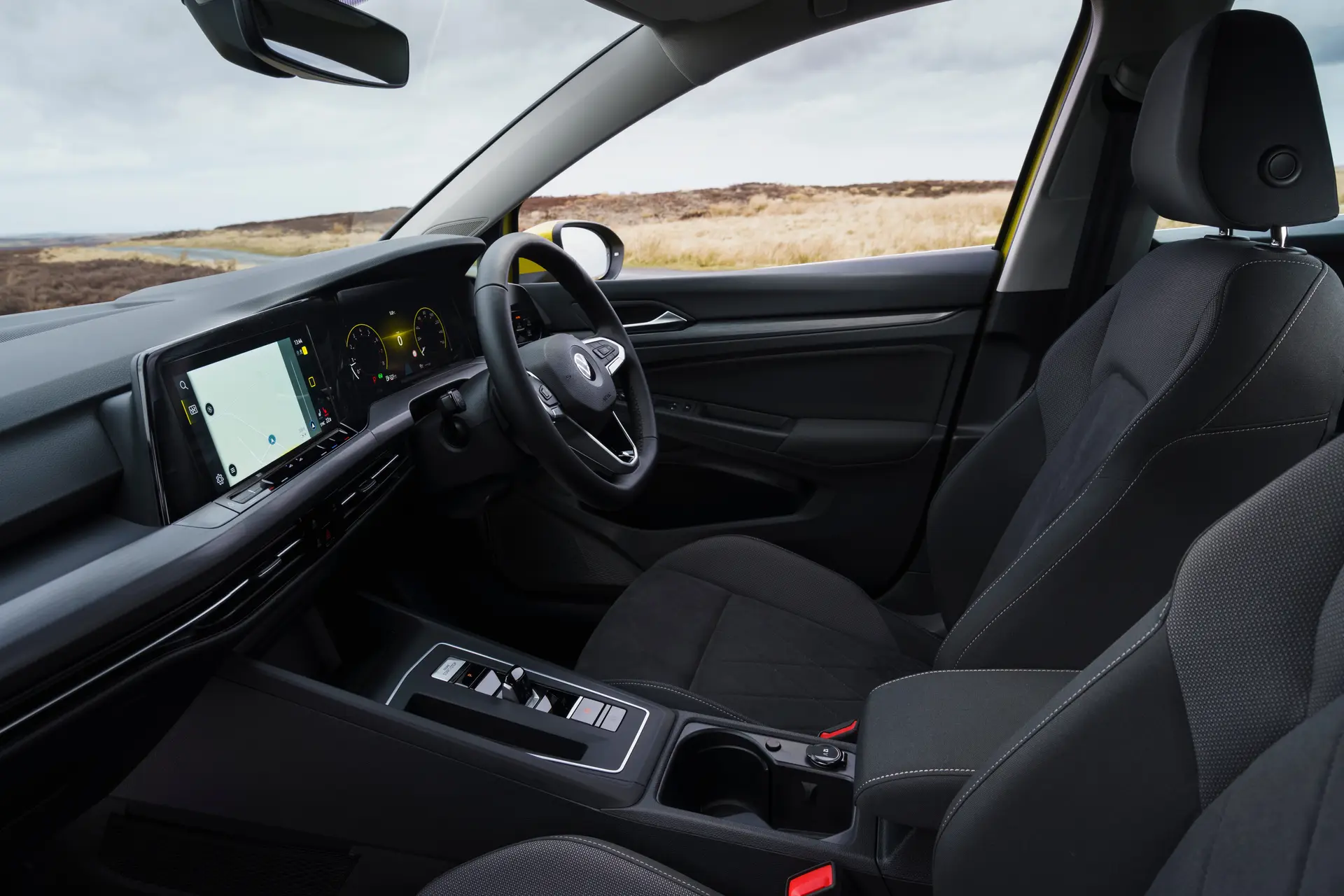
The Volkswagen Golf has a very minimalist layout, with the 10-inch infotainment screen and 10-inch high-res digital instrument cluster taking centre stage in a fairly sober but classy cabin.
There are lots of touch-sensitive buttons for things like the climate control and even controlling the car’s lights. These look pretty swish but are more than a little frustrating to use, especially on the move. Maybe we’re a little old fashioned, but we’d like a few more knobs and buttons for adjusting the temperature or changing the volume. What's more, the touch sensitive strip under the infotainment screen for the temperature and volume isn't backlit at night, so you can't use it. Baffling...
Some buyers are apprehensive about digital dials - and rightly so. They can sometimes overload you with information, when all you want is to know how fast you’re going. Fortunately, the Golf’s system is excellent. It has crystal clear graphics and you can choose from a number of different displays, allowing you to choose which suits you best. It’s easily customisable, too.
The Golf is a very easy car to get comfortable in. The front seats are very supportive, with manual lumbar adjustment across the range, and there’s plenty of adjustment in the seats and steering wheel. Indeed - we were surprised how far the steering wheel could be pulled towards the driver. It’s great if you’ve got long legs and short arms.
Quality and finish
The Volkswagen Golf has been a byword for high quality interiors since the peerless Mk4 Golf of the nineties, and this is still the case for the eighth-generation model. For the most part, anyway.
It feels very well finished, and certainly a step above the Ford Focus, with a more attractive design and a greater feeling of solidity. Its minimalist design looks very premium, helped by things like the touch-sensitive buttons and bright digital screens for both the infotainment and instrument cluster.
You can sense the ‘but’ coming. Start prodding around the cabin, and it’s a little surprising how many harsher plastics can be found. The lower half of the door cards (surrounding the door bins) feel a bit flimsy, while a big chunk of plastic on the centre console is anything but soft-touch and will start to show up dirt and scratches. It is still better than the SEAT Leon, but not by as much as it used to be.
We’re being quite picky because of the Golf’s reputation as a quality product. Its doors still close with a satisfying thud and it’ll no doubt wear very well indeed. But it’s almost like Volkswagen’s had to reign it back, in order to give buyers a reason to pay more money for an Audi A3.
Infotainment: Touchscreen, USB, sat nav and stereo in the Volkswagen Golf
It used to be that the size of the screen in your Volkswagen Golf depended on how much you spent on it, but not any more. Now, all Golfs come with the same 10-inch media system which is positioned high up on the dash in a good position for glancing at on the move.
It’s generally keen to respond, with ultra-quick responses and sharp graphics, although it can take a while to boot up when started. It looks like a smartphone, with a tiled home screen and swipeable menus.
It also operates like a smartphone, in that it’s entirely a touchscreen system. There are no shortcut buttons any more, which is frustrating, and it’s very easy to tap the wrong thing when the car’s moving. You’ll find yourself resting your fingers on the ledge below it and accidentally turning the heating up. It’s safest to leave it well alone until you’re a standstill. The Mazda 3’s rotary controller is much easier and safer to use.
Early examples of the new Volkswagen Golf were prone to software glitches in the infotainment, meaning it would lag or freeze randomly. VW claims to have fixed this in software updates, and newer versions seem better.
Apple CarPlay and Android Auto are standard, which is good thing as this means you can access apps from your phone on the move with an intuitive, familiar interface. There’s also DAB radio, Bluetooth and navigation with European mapping.
Space and practicality: Volkswagen Golf boot space
No one’s going to find a lack of space in the front of the Volkswagen Golf. There’s loads of headroom, particularly if you drop the seat to its lowest setting. The pedals are nicely separated, meaning you won’t accidentally mash more than one if you have big feet, and there’s space to rest your left foot when it’s not in use.
A wide centre console separates the driver and front-seat passenger, although you might find yourself clashing elbows on the armrest. Nevertheless, this is definitely one of the most comfortable front cabins in the class.
There are loads of handy storage spaces, too. You’ll find big carpet-lined door pockets and a handy space in front of the gear lever to store your phone (and wirelessly charge it). The cup holders are big enough for more uses, while there’s a small cubby area underneath the arm rest.
In the back, there’s a reasonable amount of room, but oddly the Golf isn't quite as spacious as the Skoda Octavia or SEAT Leon it's closely related to. That's because both of those cars get a longer wheelbase, meaning extra room for your legs and knees. Legroom in the Golf is okay, rather than astounding, but there’s plenty of headroom. The child seat ISOFIX mounting points are easy to get at, and the large side windows mean kids shouldn’t feel too claustrophobic.
As is usually the case in cars of this size, the middle rear seat is for occasional use only. It’s not as narrow as some, but you’ll still be rubbing shoulders with other passengers. There’s quite a significant lump in the floor meaning you’ll be fighting for somewhere to rest your feet, too.
Still, there are handy door pockets for storing odds and ends, and some nifty little pockets in the backs of the front seats. With the middle seat not in use, an armrest drops down and provides a pair of useful cup holders.
At 381 litres, the boot is fine for a car of this size. It’s pretty much on a par with the Ford Focus and bigger than a Mazda 3 although - again - lacks behind the Skoda Octavia. There’s a little bit of a lip for hoisting things over but access is nice and wide, and the boot is usefully square in shape. Dropping the rear seats is easy, although they’re not entirely flat. There’s also a useful ski hatch in the middle of the rear bench should you need to transport something long and thin like, er, skis.
All models come with a spare wheel, which is a satisfying sight in the case of a puncture rather than the now commonplace tyre repair kit. It does mean there isn’t a useful underfloor storage compartment in the boot, but you can create one with the standard adjustable boot floor.
In terms of exterior dimensions, the VW Golf is actually pretty compact for the class. It's 4,258mm long, 1,789mm wide and 1,458mm tall, which is shorter than both the SEAT Leon and Skoda Octavia. It's also a good chunk shorter than the Ford Focus and Honda Civic, too.
Handling and ride quality: What is the Volkswagen Golf like to drive?
"The Volkswagen Golf is available with a variety of suspension setups. Fortunately, we’re yet to try a bad one."
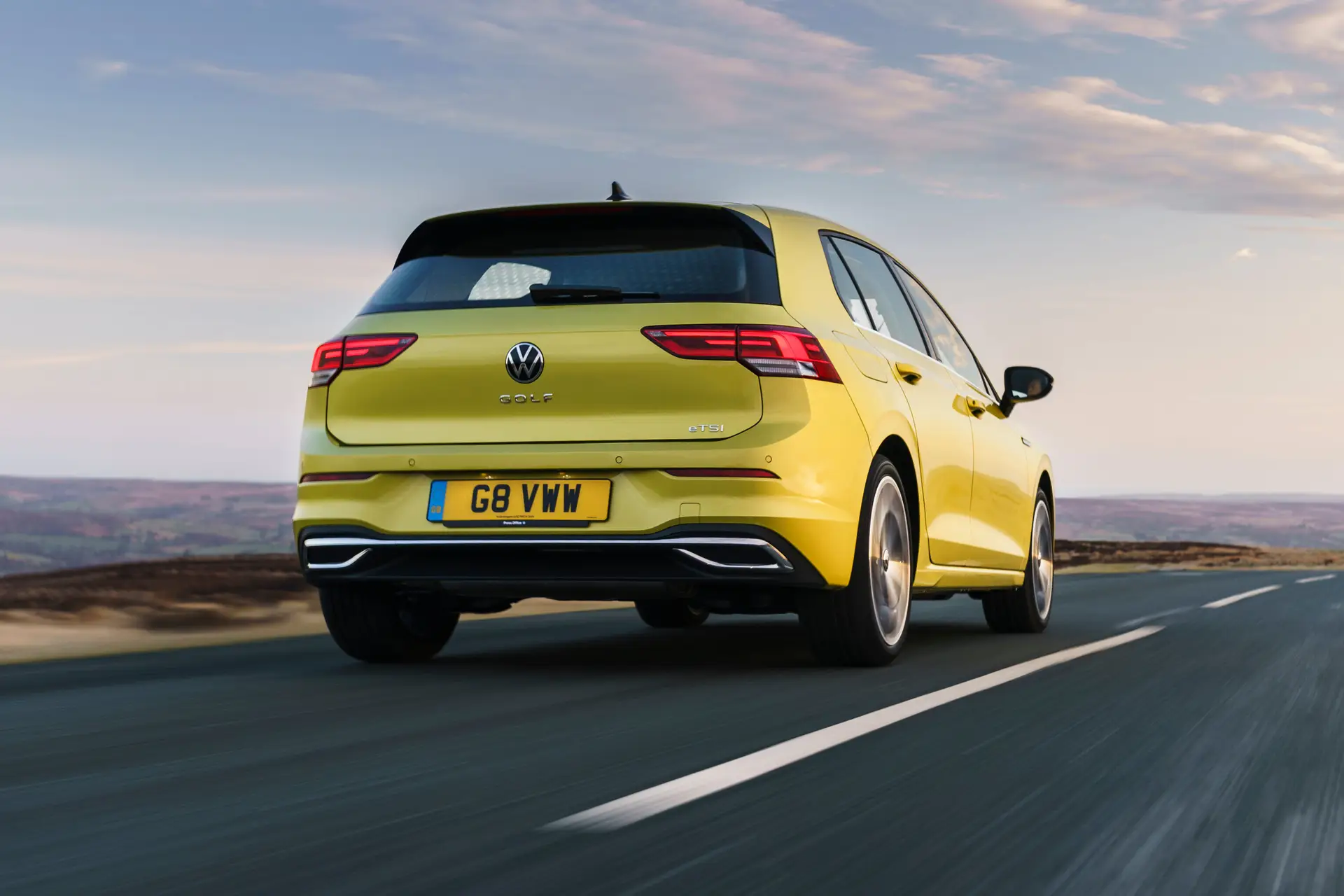
The standard suspension on the Volkswagen Golf - used on Life and Style models - is pretty compliant, soaking up bumpy roads without being too floaty. This is especially true with the smaller 16-inch alloy wheels. Sure, you might prefer the look of bigger wheels, but the smallest alloys provide an almost magic carpet ride.
R-Line models come with sports suspension which lowers the ride height slightly. As you’d expect, this provides a slightly firmer ride - especially with the bigger wheels fitted to the R-Line. It’s far from uncomfortable, though.
Look for a Golf with the optional Dynamic Chassis Control if you wish to tweak the suspension to your liking. Also known as adaptive suspension, this can increase the firmness of the suspension’s dampers in Sport mode, or soften them in Comfort mode. With Comfort mode selected, the Golf rides beautifully over broken roads.
Thanks to the Golf’s rather compact dimensions and decent visibility, it’s a very easy car for negotiating congested streets. You might not get the high-up seating position that attracts many buyers towards SUVs, but no one’s going to feel intimidated behind the wheel.
Front and rear parking sensors are standard across the range, but it’s worth looking for an example with the optional rear-view camera if you’re daunted by tricky reversing manoeuvres. Light, progressive steering helps in tricky situations, although it doesn’t feel quite as agile and engaging on the open road as a Ford Focus.
It does feel secure and planted, though, even in poor weather conditions. And it doesn’t dart around too much at motorway speeds. Look for a Golf with the optional driver profile selection (standard on R-Line) for drive modes which add extra heft to the steering when you’re feeling sporty.
What engines and gearboxes are available in the Volkswagen Golf?
The Golf’s engine line-up covers most needs, with a pair of petrol engines (one in two power outputs), a couple of diesels, and a plug-in hybrid. There's also the more powerful and sportier petrol GTI models, plus the diesel GTD and plug-in hybrid GTE.
The smallest petrol is a little 1.0-litre three-cylinder unit, producing 110PS. It’s only available in Life trim and with a manual gearbox. While it might not sound like a particularly powerful engine for a car the size of the Golf, it’s actually a really peppy little turbocharged motor, allowing the Golf to accelerate to 62mph in 10.2 seconds. If most of your driving is around town or you’re on a budget and want to keep running costs to a minimum, the 1.0-litre will be absolutely fine.
Most petrol Golfs will be powered by a 1.5-litre engine, available with 130 or 150PS. This is better suited to motorway driving, although both are only offered with a six-speed manual gearbox. The 1.5 is a rapid enough car, especially the 150PS, eager to join motorways and perform the odd overtake - providing you don’t mind dropping down a gear or two when required. it's also exceptionally smooth and refined, and fairly efficient to boot.
If you’re after an auto, you’ll need the eTSI mild-hybrid engine. This is essentially the same 150PS unit with a small electric motor and battery on hand to recuperate a small amount of energy and allow the car to coast to a stop with the engine off. It’s not a ‘proper’ hybrid, so don’t go expecting to glide around town under electric power, but the seven-speed DSG automatic transmission provides pleasingly quick responses.
Diesel offerings are made up of a 2.0-litre TDI with 115 or 150PS. The former comes with a six-speed manual gearbox; the latter a seven-speed auto. The entry-level diesel isn’t particularly quick, although its low-down torque makes it pretty effortless to drive, while the more powerful version is an ideal long-distance companion.
We've yet to try the Golf eHybrid, which uses a 1.4-litre petrol engine combined with an electric motor for 204PS. It's essentially a detuned version of the Golf GTE, with an impressive claimed electric range of 44 miles. It'll certainly appeal to business users due to its low tax, while those who do lots of town journeys will relish the ability to potter around in electric-only mode most of the time.
Refinement and noise levels
The Volkswagen Golf has the levels of refinement you’d expect from a more expensive car like the Audi A3 or Mercedes-Benz A-Class. At high speeds, it’ll isolate passengers from the outside, doing a commendable job of quashing road and wind noise.
No one’s going to mistake either of the diesels for an electric car, that’s for sure. There’s the usual distinctive rumble, especially from the 115PS model when you worked it hard. Both settle down into a refined thrum at speed, though.
The four-cylinder petrol models can be a bit noisy if you work them hard (the three-cylinder is surprisingly quiet), but they generally have enough torque that this isn’t necessary. Even the 1.5 130 is powerful enough to accelerate from 40 to 70mph without having to drop down from sixth gear, although you’ll have to be a bit more prepared to shift gears in the 1.0-litre.
The DSG automatic gearboxes help with refinement, changing gears with little hesitation and no noticeable jerkiness. Sometimes there a little hesitant to pick a gear when pulling out a junction, but you soon learn to drive around this.
The eTSI mild-hybrid can use the battery and electric motor to switch the engine off before you come to a complete standstill - making stop-start traffic a very refined affair. Of course, the plug-in hybrid is super quiet when you're in electric mode.
Safety equipment: How safe is the Volkswagen Golf?
As you’d expect, the Volkswagen Golf is a very safe car to drive and it’s loaded with safety equipment as standard, even on the most affordable models.
All Golfs come with adaptive cruise control which, as well as making your life easier on long motorway trips, also brings with it a second pair of eyes - in a sense. The Front Assist system will measure the distance between your car and the vehicle ahead, warning you if you get too close. If it detects an impending collision, it’ll warn you again and prime the brakes ready for emergency braking. At speeds of up to 19mph, the City Emergency Braking System will automatically brake for you if you don’t react in time - and boost the pressure on the brakes if you do react.
Other standard safety equipment includes many airbags, automatic headlights and an active bonnet which pops up to provide extra cushioning if you strike a pedestrian.
All models get Volkswagen’s Car2X wireless communication feature. This can exchange information with other vehicles as well as the traffic infrastructure. If there’s an incident or a hazard on the road ahead, for example, it can warn you in advance. You could even get alerts of approaching emergency vehicles - although these features will take time to work fully until the infrastructure catches up with the car.
When the Volkswagen Golf was crash tested by Euro NCAP in 2019, it received a maximum five-star safety rating. It scored an impressive 95% for adult occupants and 89% for children. It received 76% for protecting vulnerable road users, while its safety assist features scored 78%.
MPG and fuel costs: What does a Volkswagen Golf cost to run?
There is no weak link in the VW Golf engine range - all of them are among the most efficient units of their type on sale.
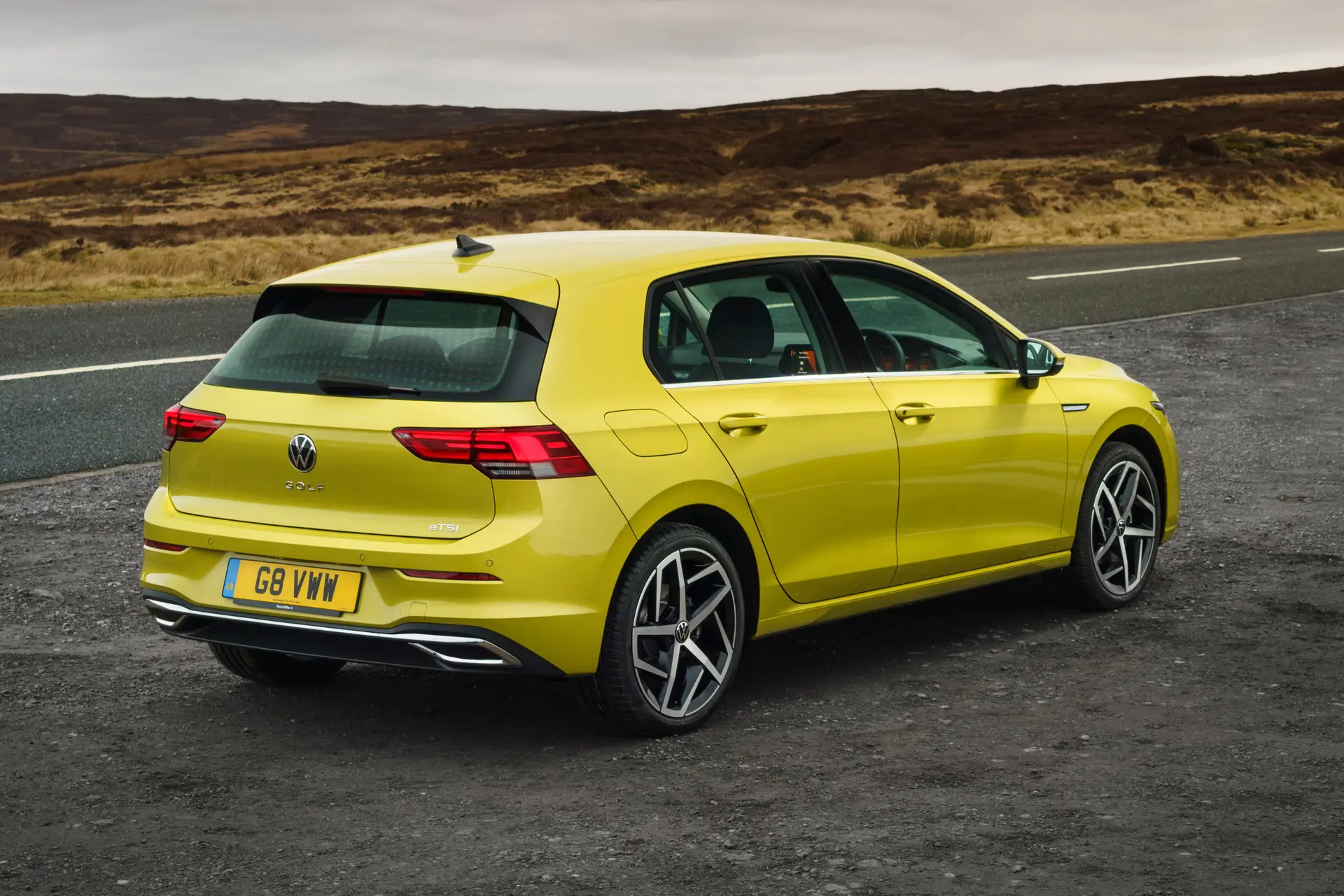
If you’re looking for outright fuel efficiency in your Volkswagen Golf, the 115PS 2.0-litre diesel will be the best option. Officially, it can return between 62.8 and 68.9mpg. That’s under the latest WLTP fuel economy tests, too, so it should be fairly realistic in the real world.
The more powerful 150PS 2.0-litre diesel with its seven-speed DSG automatic gearbox is only marginally less efficient, returning 60.1 to 62.8mpg.
The most efficient petrol is the three-cylinder 1.0-litre petrol, which can officially achieve between 49.6 and 53.3mpg. The 130PS 1.5-litre TSI pretty much matches that, returning between 49.6 and 52.3mpg. We suspect, as it’ll need working less to keep up with traffic, the 1.5 might actually be more efficient in the real world.
The slightly more powerful 150PS 1.5 sees economy drop very slightly to between 47.9 to 51.4mpg. Despite being a mild-hybrid model, the eTSI engine with its DSG automatic gearbox is the least efficient, returning 44.8 to 49.6mpg.
The plug-in hybrid models claim some quite incredible fuel economy figures (the Golf e-Hybrid promises up to 235mpg). But these figures need to be taken with a huge pinch of salt, as you'll only get near them if you charge the car up after basically every journey.
How reliable is the Volkswagen Golf?
Volkswagen scraped into our top 10 brands in the latest HonestJohn.co.uk Satisfaction Index. Owners find the cars dependable and well-made, with over 88% of owners saying they're satisfied overall.
The Golf is one of VW's newest models, with the latest tech and features. While all will still be under warranty, we do know of some niggly software issues that plagued early cars. Nevertheless, these issues can be rectified by software updates, and the Golf's engines are generally well proven.
Insurance groups and costs
Volkswagen Golf insurance groups, at the time of writing, range from 14 to 24. The Life is the cheapest model to insure, with either the 130PS 1.5 petrol or 115PS 2.0 diesel engine. The priciest is the top-spec R-Line with the 150PS diesel engine and DSG automatic gearbox, if we're excluding the GTI, GTE and GTD models.
For comparison, the least powerful Ford Focus models fall into group 11 - but insurance groups for the new Golf 1.0-litre are yet to be announced. It’s expected to offer cheaper insurance than the current line-up.
VED car tax: What is the annual road tax on a Volkswagen Golf?
After the first year (which is dependent on CO2 emissions), you’ll pay a flat rate of £155 a year in car tax on the Volkswagen Golf. The mild-hybrid eTSI model, however, is classed as alternatively-fuelled, so you’ll say £10 a year in VED - bringing your annual bill down to £140.
The plug-in hybrid VW Golfs are free to tax for the first year, and £10 cheaper than conventional petrol and diesel models for the following years.
How much should you be paying for a used Volkswagen Golf?
"The eighth-generation Volkswagen Golf is still a very new car, yet there are still some strong savings on offer."
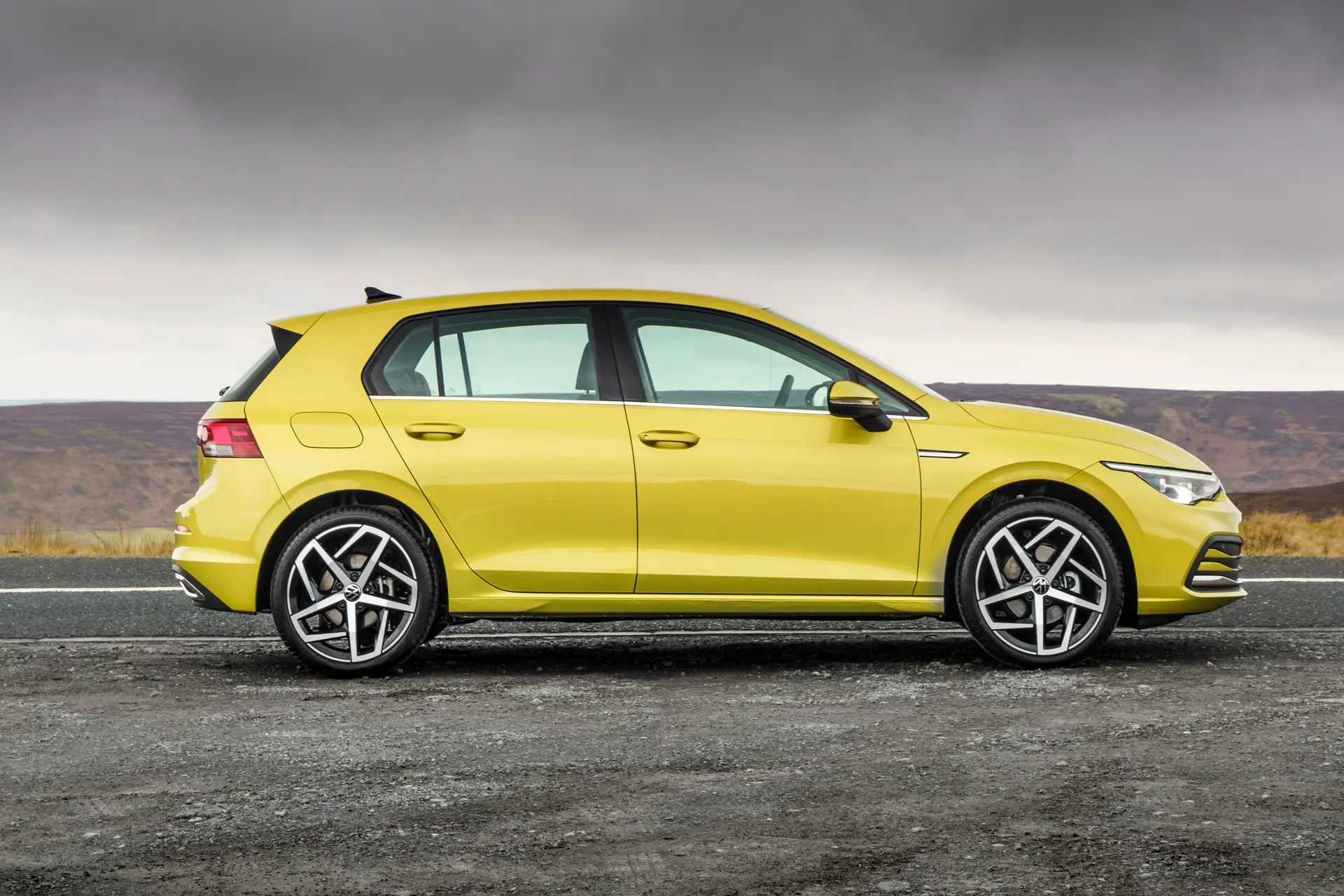
If you’re not fussed about choosing options or picking a colour, you can drive away today in a pre-registered Volkswagen Golf. These are cars that have been registered by dealers and are usually offered below retail prices.
We’ve seen mid-spec Style models with the eTSI engine on sale for just £25,000 - a saving of more than £3000 compared to list price. There are similar savings available on the more affordable Life trim - you can pick up an as-new entry-level 1.5 petrol for less than £21,000.
Trim levels and standard equipment
The standard Volkswagen Golf line-up in the UK is a very simple one. Ignoring sportier models like the GTI, there are three core trim levels: Life, Style and R-Line. Active trim was added later in the car's life, with a few key upgrades over Life trim.
The most affordable Golf Life models are pretty well equipped. Standard equipment includes a 10-inch navigation system with Apple CarPlay and Android Auto. There’s a 10-inch digital instrument cluster, wireless phone charger, climate control and fancy ambient interior lighting with a choice of 10 colours. The seats are finished in cloth, while the gear knob (on manual models) and steering wheel are trimmed in leather.
Outside, the Golf Life gets LED headlights and 16-inch alloy wheels. There’s a host of standard safety and driver assistance technology, including adaptive cruise control and front and rear parking sensors.
Golf Active models retain the rather small 16in wheels in a different design, but add tinted windows, a welcome light projection and decorative dash inserts. The ambient lighting is upgraded to 30 colours, while you also get a heated steering wheel, heated front seats, three-zone climate control and heated washer jets.
Golf Style upgrades the alloy wheels to 17-inch rims, while there’s some extra chrome exterior detailing. LED Plus headlights have a cornering function.
Inside the Style, the ambient lighting gives you a choice of 30 colours to choose from, while the climate control now provides three separate zones. There are brushed dark metal decorative inserts on the dash and door panels, while the steering wheel gets matt aluminium surrounds. Front sport seats with height and lumbar adjustment are standard, with microfibre side bolsters. High-beam assist will take care of dipping your headlights in the dark.
Topping the range is the sporty and stylish Golf R-Line model. This adds sportier 17-inch alloy wheels, various bits of bespoke exterior detailing (such as the bumpers and side skirts) and tinted rear windows. There’s lowered sports suspension, while drivers can select from a multitude of different drive modes. The front sport seats now featured integrated head restraints and embossed R-Line logos.
Ask the heycar experts: common questions
Is VW discontinuing the Golf?
How much do VW Golf's cost?
Is the Volkswagen Golf a good car?
Stay up to speed with great offers plus the latest car news and reviews
Keep me updated by email with the latest advice, news and offers from heycar.
By submitting you agree to our privacy policy

